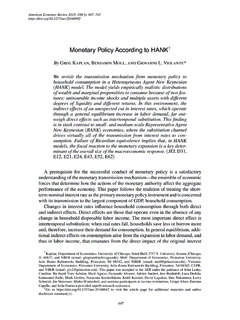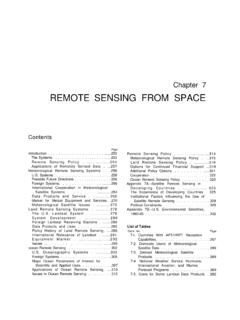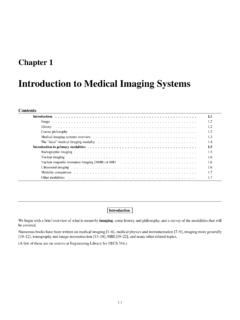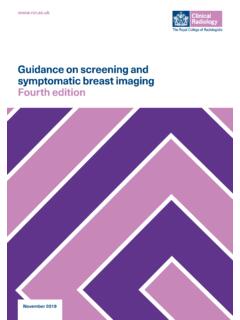Transcription of Introduction to Digital Subtraction Angiography
1 To DigitalSubtraction AngiographyIntroduction to DigitalSubtraction AngiographyDigital Subtraction Angiography (DSA) is a newradiographic technology used in diagnosing vas-cular disease. DSA is employed to obtain imagesof arteries in various parts of the body and ishighly effective in contrasting arterial structureswith their surrounding bone and soft tissue (3).DSA has proven especially useful in the identifica-tion of vascular abnormalities, including occlu-sions, stenoses, ulcerated plaques, and aneurysms(21,58,107).
2 The potential importance of DSA in the diag-nosis of cerebrovascular disease is suggested byReuter s (87) observation that as much as one-TECHNOLOGICAL DEVELOPMENTThe development of DSA was a result of theresearch of medical physics groups at the Univer-sity of Wisconsin, the University of Arizona, andthe Kinderklinik in Kiel, West Germany duringthe early 1970s (21,58,74). Fundamental advancesin intravenous arteriography, which had been in-termittently used since the 1930s, were made pos-sible by the Introduction of cesium iodine imageintensifiers and advances in Digital electronicmethods of storing and manipulating information(21).
3 By 1978, the feasibility of DSA for humansubjects was demonstrated, and prototype com-mercial DSA systems were introduced in 1980 atthe Universities of Arizona and Wisconsin, theCleveland Clinic, and South Bay Hospital inRedondo Beach, California (57,58,74). There arequarter of the combined volume of neuroradiol-ogy and Angiography services in some medicalcenters is now directed toward evaluating carotidand cerebral atherosclerosis, including stroke.
4 TheCooperative Study of Transient Ischemic Attacks(TIAs) (102) reported an average of definiteTIAs per 100 acute beds per year in the partici-pating medical centers. Estimates of the use ofarteriography procedures for these hospitalizedpatients range between 87 and 97 percent (23).DSA will either supplement or replace a large por-tion of the arteriographic nearly 20 manufacturers of DSA systems andmany more in the process of developing new sys-tems (18).
5 The size of the market for DSA equipment issomewhat difficult to estimate because of the un-certain future of demonstrated uses of DSA in cor-onary Angiography . A spokesperson for one ofthe major manufacturers of DSA equipmentshared two projections of investment bankingfirms for all types of DSA units for the periodfrom 1982 through 1986. One firm projected totalsales of 5,160 units, while the other firm projectedsales of 9,800 units for the same period.
6 Therewere estimated to be about 600 DSA units of alltypes in operational status as of January METHODS AND CLINICAL APPLICATIONSWith respect to cerebrovascular diagnosticin the evaluation of the extracranial circulation,studies, both intravenous and intra-arterial DSAespecially the carotid arteries, in most been employed. However, in this case studythe notation DSA is used to signify intravenousapplications only. The focus is limited to intra- As of October 1983, when this case study was submitted to OTAvenous DSA, because it is the method employedfor final systems work in the manner depicted infigure 3-1 as follows: a contrast medium is injectedintravenously; X-ray detection of the contrastmedium produces 1 to 30 exposures per second(before and after the injection of contrast me-dium).
7 And arterial images are converted fromanalog to Digital form and transmitted to a com-puter-storage complex (55). The digitalized im-age information makes it possible to subtract the precontrast images from those obtained aftercontrast injection so as to visualize arterial struc-tures without direct arterial puncture and injec-tion. The data can be recalled for viewing on avideo screen, and successive images createdthrough Subtraction techniques which allow thecontrast of the arterial structures to be visualizedfor the detection of purpose of the Subtraction process used inDSA is to eliminate (or factor out) the bone andsoft tissue images that would otherwise be super-imposed on the artery under study (12,58).
8 Theserial images show changes in the contrast appear-ance over time (temporal Subtraction ) and at vary-ing X-ray intensities (energy Subtraction ) (12,57).Most DSA examinations require 25 to 45 min-utes to perform (63,99,112), if there are no tech-nical complications ( , difficulties with catheter-ization), and can be performed on an outpatientbasis. This is a considerable advantage in safetyand cost over most standard arteriographic ex-aminations, which require at least overnightobservation of the patient in the hospital to detectpost-procedure arterial obstruction or hemorrhage(24,33).
9 However, a small number of the latterhave been safely performed on an ambulatorybasis in recent years (45).DSA has a wide range of clinical applicationsin addition to its use in carotid artery and his colleagues (74) at the Univer-sity of Wisconsin have substituted DSA for stand-ard arteriography in the evaluation of aortic archanomalies, aortic coarctation, and vascular by-pass grafts. Digital Subtraction techniques havealso been used for imaging of the abdominal, car-diac, pulmonary,carotid, intracerebral, andperipheral vessels.
10 Table 3-1 provides an overviewof the range of attempted applications of DSA im- aging technology reported in the literature. Be-Figure 3-1. Diagram of a Digital Subtraction Angiography (DSA) SystemIIIII/IIIIIIIIIIIII;IIIISOURCE: Office of Technology Assessment. Adapted with permission of the General Electric Co, from G. S. Keyes, N. J, Pelc, S, J. Riederer, et al., Digita/ F/uorographyA Teclmology (@date (Milwaukee, Wl: General Electric Co., 1981),17 Table 3-1.)


















